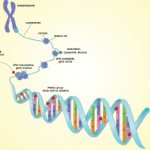Given this new understanding, he said the challenge is to understand where all the switches are, what they regulate, and how they are regulated.
More Refined View of the Genome
Dr. O’Shea opened his talk with a metaphor to illustrate how the focus on switches versus genes has refined the current understanding of the genome and its association with diseases. He said the old way of looking at the genome was like a Neanderthal man coming into the lecture hall who, when asked to turn off the lights, would try to climb up to the ceiling to smash the light itself, not knowing that there are switches on the wall for turning off the light. The current view that switches control gene expression now focuses investigation on finding the switches. What makes this even more interesting and challenging is that even if a switch is near a gene, it may or may not regulate that gene. The switch that regulates a gene may be near or far from the gene.
Important types of switches in the genome that regulate genes from a distance are known as enhancers, and a subset of enhancers known as super-enhancers contain huge numbers of regulatory elements. According to Dr. O’Shea, the genetic risk of various types of disease appears to be enriched in these super-enhancer areas.
“All of us have switches, but a sequence of your switches and my switches may not be the same, and that may affect how genes are regulated,” he said, adding that this may determine the different genetic risk of disease among people.
Added to the complexity of disease development, he said, is the role played by the environment. “The other part of the epigenome is that it is responsive to the environment, so the epigenome can be modified,” he said. “It is not just the genes, it is how the genes are allowed to be turned on, silenced, or in a configuration that allows them to be active.”
Learning From Oncology
Although applying this view of the genome to a better understanding of the pathogenesis of rheumatic diseases and finding new therapeutic agents for these diseases may be relatively new to rheumatologists, Dr. O’Shea said that oncologists have already developed drugs based on their efforts to understand the epigenome in cancer.
Noting that a number of original drugs currently used to treat rheumatic diseases, such as methotrexate, were first used to treat cancer, Dr. O’Shea said, “This may be another circumstance where rheumatologists learn from oncologists.”


